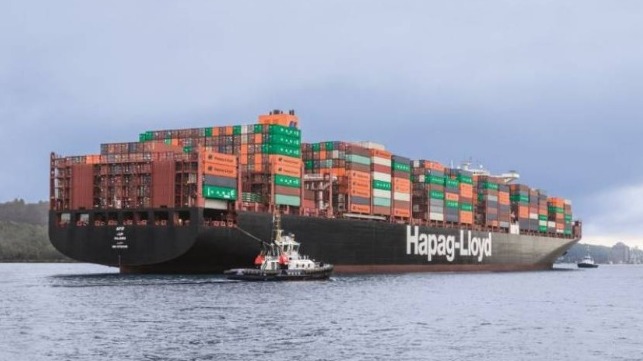Hapag-Lloyd Reports Record Quarter with 10-Fold Increase in Profits

Hapag-Lloyd became the latest major carrier to report record results following a pattern seen by all the lines during the third quarter and for all of 2021. The German liner firm, which is ranked fifth largest by Alphaliner reported, termed its performance in 2021 “extraordinary strong results,” with a record all-time quarter that saw profits jump by nearly 10-fold.
“Despite all the operational challenges, we achieved an extraordinary strong nine-month result. However, global supply chains are under enormous pressure, which further intensified during the peak season in the third quarter. This unfortunately also creates additional operational burdens for carriers, ports, and terminals – but, most importantly, for customers worldwide,” said Rolf Habben Jansen, CEO of Hapag-Lloyd.
Like the other carriers, Hapag credits the “much higher freight rates thanks to persistent excess demand,” as the key driver to the company’s strong results. Rates were up more than 100 percent year over year and despite the well-publicized recent dip, Jansen said that he felt rates will remain high and did not decline as much as possible due to the continuing near-term issues in the market. For the nine months in 2021, the company averaged a freight rate of $1,818 per TEU.
While the rates soared driving profits, volumes were up just modestly for the quarter and the year. “Volumes were largely in line with our expectations,” told investors saying that the company had done everything it could to address the capacity constraints. He pointed to three challenges so far in 2021 starting with the fact that they did not have enough containers and the boxes were not in the right place when the surge began. Jansen said the company has largely recovered from this challenge by buying more boxes and getting them most of the time into the right position. He admits that there are still some shortfalls but more points to the capacity constraints and inefficiencies across the supply chain.
“We moved capacity to high demand trades. We tried to find alternate gateways. We tried to buy secondhand tonnage. We put in additional vessels. We deployed extra loaders,” he said while predicting that the operational challenges remain and that normalization is not expected before the first half of 2022.
Among the operational challenges, Jansen points to congestion, which as expected was pretty severe which created the problem of having quite a bit of volume stuck on ships. Time charter costs were also up as were bunker and extra costs related to the congestion. Still, Hapag reported a nine-month profit of $6.7 billion driven by a 70 percent increase in revenues to $17.9 billion for the nine months.
“There’s a lot that can still be done in terms of efficiency, not only at the ports but at the warehouses, where they only accept boxes during certain times of the day and certainly not at night. If we all think a bit more 24/7, we would actually create an enormous amount of additional capacity,” said Jansen. He showed charts that illustrated a 300 percent increase in waiting times at North American ports but also cited a strong increase in delays in Asia as well as some in Europe. He highlighted a five percent decline in port capacity saying that between five and ten percent of Hapag’s capacity is tied up due to port congestion. He, however, contends that ports have a five percent lower productivity contributing to many of the current challenges.
Saying that demand is expected to continue to slightly outgrow supply in both 2021 and 2022, he forecast that the strong earning increases will continue while reaffirming the recently raised earnings guidance. Hapag in October raised its forecast to $10.3 to $11.3 in earnings before interest and taxes for 2021.
